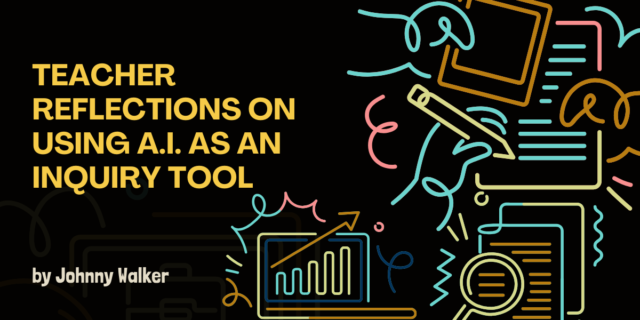
The following is adapted from Comprehension and Collaboration: Inquiry Circles for Curiosity, Engagement, and Comprehension by Stephanie Harvey and Harvey “Smokey” Daniels.
This may seem obvious, but too often we think of reading as simply word calling. Steph remembers a morning when she was sitting quietly conferring with a student during reading workshop. Suddenly, DeCoven, another fourth grader who’d been reading silently at his seat, shattered the silence by blurting out, “Reading is thinking!” The kids in the room were practically shaken out of their skins and it took a while to recover. You know fourth graders! But Steph couldn’t have been more delighted, because at the beginning of the year DeCoven was a kid who had described reading as “sounding out the words,” “answering questions at the end,” and, worst of all, as “something I hate to do.” And now, here he was reading independently in a book he had chosen and having a very public AHA! His teacher had been modeling thinking strategies for the class that fall, and at the very moment when DeCoven realized that reading was about more than sounding out words, he simply had to blurt it out! DeCoven nailed it; reading is thinking! This was one of those goose bump moments.
Comprehension is not about answering those literal questions at the end of a story, chapter, or textbook section. Comprehension is not about spitting out facts and filling in blanks. Comprehension is about understanding. And reading is not merely about word calling. Reading is about thinking. We haven’t always realized this, however. For years, comprehension wasn’t even taught, it was merely tested—and tested inappropriately at that, by having kids answer those literal end-of-text comprehension questions. As we experienced with the Uhlenbeck passage, answering literal questions does not guarantee understanding. If students can answer those questions, they might have understood it—or not. If they can’t answer those questions, they might have understood it—or not. Most frequently, students can easily answer a literal question, but they don’t understand the concept.
Jessica, a third grader who had been taught to merge her thinking with the information, jotted down an L for learn when she learned something new from a book about animals. She learned quite a bit of information: that snails do not look after their eggs, that pandas like bamboo, and that wool is fiber, among other things. If we had created a quiz with a list of multiple-choice questions for the end of reading, she probably would have chosen the correct answers.
1. What do pandas eat? (bamboo)
2. Do snails look after their eggs? (no)
3. What is wool made of? (fiber)
The problem, as we can see from the fiber Post-it note, is that although she wrote down that wool is a fiber, she didn’t know what fiber was. She didn’t understand the concept, but she could easily answer the question. We see this over and over again with kids in school; they can answer the questions but they don’t understand the information.
Fortunately for Jessica, her teacher had taught her to think about information as she read and to ask a question if she didn’t understand, which is exactly what she did when she drew a line under the phrase and asked, What is fiber? The Post-it reveals a great deal about Jessica as a reader: She is thinking. She is monitoring her understanding. She knows when she does not understand. She knows that reading should be about understanding. She knows to ask a question to clarify confusion. An added benefit of having kids interact with text while reading rather than spend their days filling in blanks and bubbles is that we learn so much from their written responses. We can usually tell whether they understand or not and we can respond with appropriate instruction.
Understanding emerges from thinking. We lay down a foundation of thinking as we teach because kids learn, understand, and remember so much more when they think actively about the text and then talk to each other to enhance their understanding.

Explore additional Reading instruction resources here.

Harvey “Smokey” Daniels has been a city and suburban classroom teacher and a college professor, and now works as a national consultant and author on literacy education. In language arts, Smokey is known for his pioneering work on student book clubs, as recounted in Literature Circles: Voice and Choice in Book Clubs and Reading Groups, and Minilessons for Literature Circles. His latest bestselling books on content-area literacy are The Curious Classroom; Comprehension & Collaboration, Second Edition; Upstanders; Subjects Matter, Second Edition; the Texts and Lessons series; and Content-Area Writing. He is also coauthor of Best Practice, Fourth Edition, and The Best Practice Video Companion as well as editor of Comprehension Going Forward.
Smokey works with elementary and secondary teachers throughout the United States, Canada, and Europe, offering demonstration lessons, workshops, and consulting, with a special focus on creating, sustaining, and renewing student-centered inquiries and discussions of all kinds. Smokey shows colleagues how to simultaneously build students' reading strategies, balance their reading diets, and strengthen the social skills they need to become genuine lifelong readers.
Connect with Smokey @smokeylit.

Stephanie Harvey has spent her career teaching and learning about reading and writing. After fifteen years of public school teaching, both in regular education and special education classrooms, Stephanie worked for twelve years as a staff developer for the Denver based Public Education and Business Coalition (PEBC), a partnership of leaders from education and business, who support innovation in public schools.
Insatiably curious about student thinking, she is a teacher first and foremost and currently serves as a private literacy consultant to schools and school districts. In that role, she conducts keynote speeches, presentations, workshops, demonstration lessons, coaching sessions and ongoing consultation to teachers, reading specialists, literacy coaches, principals and district administrators. With a focus on K-12 literacy, her specialties include comprehension instruction, inquiry-based learning, content area reading and writing, nonfiction literacy, and the role of passion, wonder and engagement in teaching and learning.
Stephanie has written many articles, books and resources; her Heinemann publications include the title Comprehension and Collaboration which she co-authored with Smokey Daniels, and The Comprehension Toolkit series which is an in-depth Curricular Resource for comprehension instruction co-authored with Anne Goudvis.
Connect with Steph @StephHarvey49.


